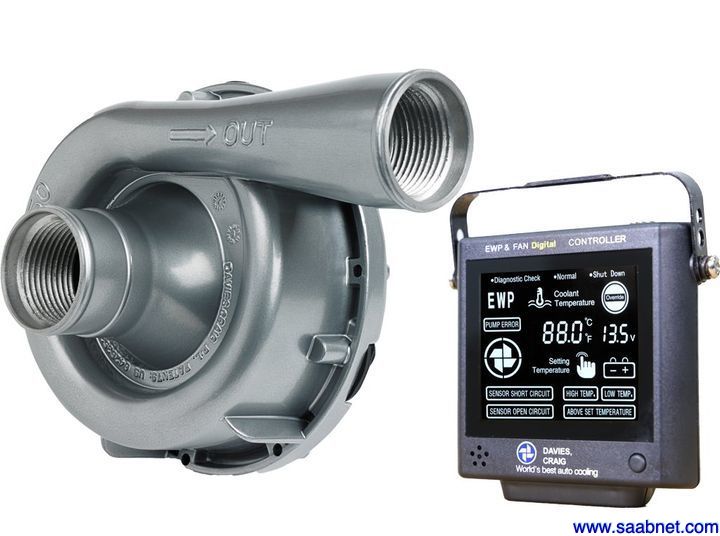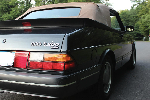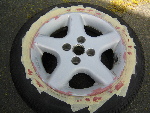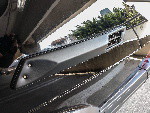
1994-2002 [Subscribe to Daily Digest] |
| [Main NG900 & OG93 Bulletin Board | BBFAQ |
Prev by Date | Next by Date | Post Followup ]
Member Login / Signup - Members see fewer ads. - Latest Member Gallery Photos
should OEM water pump be serviced? YES replaced w/ electric!  1 Saabers Like This Post! 1 Saabers Like This Post!
Posted by neil dale [Email]  [Profile/Gallery]
(more from neil dale) on Tue, 4 Jan 2022 20:18:00 [Profile/Gallery]
(more from neil dale) on Tue, 4 Jan 2022 20:18:00
In Reply to: Re: Should a water pump be serviced? Or better not to touch?, Jeremy R., Fri, 19 Nov 2021 20:20:14 Members do not see ads below this line. - Help Keep This Site Online - Signup |
i believe in preventative maintenmence and one thing we learned from our Ferrari is thing go bad due to TIME not just miles!
the service schedule calls for items to be replaced due to TIME not just miles!
it is GOOD advice and IF you replace something BEFORE it fails you save grief, expense and inconvienece !
the best idea i have seen lately, ( and one i plan to do is install a auxiliary electric water pump ! SAABS have a horrible heat soak issue they get hotter AFTER you shut them off!
NOT GOOD !
so we will have one of the simple electric boost pumps installed in the lower radiator hose and controlled thermostaticly when the car is running and it will also flow coolant AFTER shutdown ( and run the fan(s) until the temp reaches a preset level TBD
One posited reason for slugging and turbo seal/ bearing failure is HEAT and the oil coking in the turbo after shutdown !
eventually we will just eliminate the mechanical pump altogether and go all electric ! they are MUCH more reliable and give perfect temp control FLOW based on DEMAND !
electric water pumps !
GREAT IDEA ! been wanting to do this for a LONG time ! electric water pump ! for the whole car ! and the turbo ! = longer life !
Setting up a water-cooled turbocharger using an Electric Water Pump
25/11/2020 12:00AM
General Electric Water Pump Davies Craig Davies Craig Drifting water-cooled turbocharger Intercooler turbocharger explained turbocharger install turbocharger balancing turbocharger basics turbocharger car turbocharger cooling system turbocharger efficiency electric water pump 12v electric water pump installation electric water pump advantages
Aussie Manufacturer Davies Craig Pty Ltd has been at the forefront of the automotive cooling business for almost 50 years!
As well as developing Thermatic Electric Fans, 1996 the company turned its attention to engineering a unique rock-solid range of remote-mounted Electric Water Pumps, the company also supplies a broad range of compact Electric Booster Pumps. Some of these EBP models find their way into water-cooled turbocharger kits. There is also a growing trend to make use of the compact remote-mounted Electric Water Pumps with some inter-cooler and turbocharger applications!
There are many benefits to utilising a cooling system for a turbocharger and plumbing in an Electric Booster Pump (EBP®) or Electric Water Pump (EWP®). We all know heat, more specifically heat-soak can shorten engine, turbocharger, supercharger life and can destroy engine components. An appropriately plumbed cooling system for your turbocharger or supercharger will provide significant benefits to performance and well worth the effort required to install an adequate cooling system.
What does engine coolant really do?
Liquid cooling improves mechanical durability and extends the life of a turbocharger. Many turbochargers are designed to be sufficiently cooled by air. Other turbochargers are specifically designed and have built-in ports. Consequently, coolant and/or oil can be pumped through the main body. How can we tell the difference between an air/oil-cooled turbo and an oil/water-cooled turbo? If the turbocharger’s housing has threaded ports on either side, at 90° from the oil inlet/outlet flanges, it is probably a liquid-cooled model. To meet durability targets a turbocharger needs coolant running through its system. The major advantage of liquid cooling is coolant can be circulated after hot engine shut down. Heat generated in the turbo housing and exhaust manifold soaks into the centre section of the turbocharger. If coolant is not plumbed through correctly, the extreme heat can potentially destroy expensive turbocharger components.
How does liquid cooling work?
The process of a liquid cooled turbocharger can be orchestrated in two ways. During normal engine operation coolant flows through the turbocharger via the mechanical water pump. However, thermal siphoning can pull some coolant through the turbo’s centre housing or it can be pumped through properly routed coolant lines. Remember, a mechanical water pump stops when the engine is shut down which means coolant effectively stops circulating. This is where an auxiliary Davies Craig Electric Water Pump and/or Electric Booster Pump can be installed to assist with the component cooling process.
Heat built up in the centre housing is transferred to the coolant via conduction just like the cooling effect that occurs in a typical water-cooled engine through the built-in coolant capillaries. If coolant within a turbocharger flows freely after absorbing heat, it will circulate through the cooling system drawing colder coolant into the turbocharger along with it. In this way, the intense heat that has soaked back into the turbo after engine shutdown is removed from the turbo components and avoiding serious damage without assistance from the engine’s mechanical water pump.
How does liquid cooling extend turbo life?
Turbochargers generate an enormous amount of heat. Heat-soak is a huge factor with turbochargers, can ‘kill’ them fast and must be brought under control after engine shut-down. Heat originates in the exhaust system and during solid use, high exhaust temperatures unload enormous quantities of heat into the exhaust manifolds, turbine housing, and turbine wheel. While designed to manage extremely high temperatures some heat will want to naturally dissipate into the less heat tolerant centre housing and associated components as they are all inter linked. While the engine is operating and oil is flowing through the turbo’s bearing system, most of the heat generated may be cooled by the oil, preventing damage to the bearings and oil seals.
Obviously after engine is shut-down oil flow stops and so does the exhaust flow through the turbine. But intense heat is still evident in the exhaust manifold and turbine housing and it must be dissipated fast. The heat can only dissipate via conduction into the turbo’s centre and the exhaust pipe or radiate into the surrounding air under the hood. A small amount of heat will be transferred naturally to the surrounding air, but the majority will transfer from the turbo housing into the centre housing since the centre housing is at a lower temperature. Additionally, some of the heat will travel from the turbine wheel into the shaft and out towards the bearing system.
During the cool down phase heat creeps via heat soak into the turbo’s centre which lifts heat into the turbo’s centre. The temperatures of the centre housing, oil seal, bearings and any oil remaining in the turbo are all elevated above the normal operating temperatures, since the oil flow is no longer available to dissipate heat. Therefore, there is a greater risk for damage to the turbo during heat soak after engine shutdown.
Does your turbo have adequate cooling?
The above has given you a basic overview of the functionality of a liquid cooled turbocharger. We have also outlined that extreme heat is generated during operation and you can now understand the consequences of insufficient cooling. Turbocharger components can start to rapidly degrade at temperatures above 150°c (300°f) and risk permanent damage when exposed to these temperatures.
These temperatures may seem low when one examines exhaust gas temperatures which can reach 980°c (1800°f) and upwards in a high horsepower turbocharged engine. Examining liquid cooling specifically, the water jacket inside the centre of the turbocharger housing which is designed to keep all component temperatures below the limits to prevent premature failure. When coolant is not used or not plumbed correctly, component temperatures can easily go over limits and ultimately result in catastrophic turbo failure.
What is the right way to set up a water-cooled turbocharger?
Water-cooling a turbocharger does not need to be a complex project. The damaging effects of heat soak can be prevented from destroying the turbocharger through proper installation of the appropriate lines in the cooling system. The turbo’s coolant lines should be plumbed into the engine’s existing cooling system and can be teed off of the heater lines if they are still present in the vehicle and convenient. Engine coolant can be deployed without any concern. One can use 50/50 glycol/water mixture with most turbochargers. To receive the most benefit from water-cooling, the turbocharger’s centre housing should be rotated around the central axis (the shaft) so that the water ports are at an angle of approximately 20° from the horizontal. This is necessary to promote the thermal siphoning effect discussed earlier.
The coolant input (colder side, from the engine’s cooling system) should be plumbed into a port in the housing. The hotter output coolant returning to the engine’s cooling system should be plumbed into the higher port and allowed to travel “uphill” to the engine’s cooling system. Ensure there are no kinks in the return line. Select a port on the side of the turbocharger as an outlet. Coolant plumbing, colder coolant entering the low side, leading into the rotated centre housing and exiting the higher side, will reduce the formation of air pockets and allow unrestricted flow during hot engine shut down. The full benefits of a Davies Craig Electric Water Pump will be realised, and internal turbo temperatures will be minimized. The high temperatures in the centre housing can be reduced by as much as 50°c (90°f) when the centre housing is rotated to allow the hotter outlet coolant to exit from the higher port. With this brief explanation as to the benefits of adding an Electric Water Pump and circulating engine coolant through the body of any turbocharger during and after hot engine shut down should convince the sceptics of that water cooling is a critical element to the longevity of the unit’s components.
Several differing types of coolant lines can be utilised and there are several guidelines to follow. Be sure to use hoses or lines that are rated to at least as high as 120°c (250°f) or higher in some cases. The lines or hoses should be compatible with coolant and -AN fittings are recommended for simple, leak-free installation. Steel lines or flexible lines can be used but ensure they will cope with normal engine vibration. Most automotive engines are water-cooled, which means plumbing in a water-cooled turbocharger should be straightforward.
In summary, water-cooling is an important and straight forward requirement for turbochargers that are equipped with water ports. The consequences for overheating a water-cooled turbocharger can be terminal and destructive. The reward for a thoughtfully laid-out water-cooling system in good working order is a turbocharger that will be allowed to live the longest life possible under the extremely demanding conditions that it must withstand. Putting in some thought to examine appropriate coolant connections for your turbocharger, should reward you with excellent performance and longer life in your vehicle.
ELECTRIC WATER PUMPS
WHY SELECT AN ELECTRIC WATER PUMP?
The Mechanical Water Pump is one of the last mechanical components of the modern engine which has long been considered an inefficient device designed as an accessory on the earliest engines.
A mechanical belt driven water pump runs at the same speed as the engine regardless of how hot the engine is. Example: when travelling at high speeds down the freeway, the engine require less cooling as ram air is naturally cooling the engine however the engine speed is high as is the mechanical water pump thus providing excessive cooling whilst draining the engine of power. In heavy traffic with high ambient, the engine is idling or slow and so is the belt driven mechanical pump even though in this condition, extra coolant flow is required to cool the engine. So it works very efficiently when it’s not required and very inefficiently when it is required. The EWP® corrects this inherent flaw by delivery maximum cooling when it’s needed.
With an EWP® & Fan Digital Controller (12 & 24V) (PATENTS: USA 6425353, EU 1133624, AUS 756453), the speed of the pump is managed by the controller which varies the supply voltage to the pump and so varies the speed of the pump up or down hunting for a target temperature. When the engine reaches the target temperature, the controller locks on whilst constantly changing the Electric Water Pump speed to account for traffic and throttle conditions whilst all the while maintaining the target temperature independent of the engine speed. When the EWP® struggles to maintain your target temperature, the Digital Controller will operate the engine’s electric fan automatically once the engine has reached +3°C (+5.4°F) above the targeted / set temperature. Another significant benefit is that the Controller allows the EWP® & Fans to run on after ignition shutdown for either 3 minutes or -10°C (-14°F) of set / target temperature to eliminate heat soak.
BENEFITS OF AN ELECTRIC WATER PUMP
The main benefit for using an EWP® is resolving an overheating engine issue & improved engine temperature control.
Other important improvement for your vehicle comes from the power the mechanical pump takes from the engine can be reclaimed with the use of an EWP® hence the fuel savings and increased horsepower. By removing the parasitic power losses of belt-driven water pumps, the EWP® may provide up to 10kw of extra power and additional fuel savings. The engine power used by the mechanical pump increases as the cube of its speed – so when the mechanical pump speed doubles from idle speed say; 600rpm to 1200 rpm, the power it takes increases by eight times. Then another eight times going to 2400 rpm, and so on up to maximum engine speed. It is this extra power and torque that is released by deleting the mechanical pump that provides the fuel savings that is estimated to be 3.5% to 10%.
Major European Manufacturers have implemented EWP’s® as standard issue on a number of their vehicles and our research shows that an EWP® uses 90% less energy than conventional systems, i.e.: the mechanical water pump. Other advantages will include lower emissions by virtue of faster engine warm up, better engine temperature management, eliminating engine heat soak and improved engine life.
Weight reduction is another benefit and key requirement of any automotive manufacturer seeking fuel savings and better performance. Our EWPs® weight between 900 grams up to 1,151 grams dependent on the EWP® model whilst a typical mechanical pump is in the range of 3kg up to 5kg. Not only is our EWP® considerably lighter, the universal flexible mounting around the engine bay provides options when seeking space within a crowded engine bay for other modifications.
EWP® INSTALLATION OPTIONS
AUXILIARY OR REPLACEMENT
An EWP®, can be used as an auxiliary pump in addition to the existing belt driven mechanical water pump to significantly improve cooling or as a replacement water pump to again improve cooling while at the same time increasing power to the drive wheels and saving fuel.
As an auxiliary pump, about 4 inches of the lower radiator hose is removed, and the EWP® is inserted in the gap. The EWP® is then wired through a thermal switch, sometimes the same switch which operates electric radiator fans, and both the fans and EWP® are connected directly to the battery. In this set up, when the engine reaches the thermal switch cut in temp, both the fans and the EWP® will turn on and cool the engine, to the switch off temperature. When the engine is hot and idling, the mechanical pump will be moving coolant at about 15 litres per minute, while the EWP® will kick in with up to an extra 150 litres per minute, and so dump a huge amount of heat. If you upgrade from the switch to our digital controller being wired to the battery, on hot shut down, the fans and EWP® will run for about half a minute and wash out heat which will protect the head gasket and other components from excessive heat damage.
DISABILING THE MECHANICAL WATER PUMP
Leaving the mechanical water pump in place, install the EWP® into the bottom radiator hose and remove the manufacturer’s thermostat.
You will need to bypass the water pump pulley by installing an appropriate length belt. This method makes for an easy installation.
If running the pump continuously, remove the thermostat and drill two approx. 3mm (1/8") holes in the thermostat plate to allow some coolant circulation. Re-install ensuring that the thermostat housing is clean and a new gasket is used if required.
DISENGAGED MECHANICAL WATER PUMP (RECOMMENDED)
Remove the mechanical water pump and remove the thermostat.
Then remove the impeller from the mechanical pump shaft. Retain the mechanical water pump using the pump pulley as an idler to avoid re-routing the drive belt.
Block any bypass passages and re-install the disengaged water pump ensuring that all gasket surfaces are clean and the new gaskets are properly fitted to prevent leaks.
Install the EWP® into the bottom radiator hose..
REMOVE MECHANICAL WATER PUMP (IDEAL)
Remove the mechanical water pump and thermostat from the engine.
Install a Davies Craig EWP® Block Adapter or blanking plate (not supplied). Ensuring the gasket surfaces are clean and the appropriate gasket or sealant is used to prevent leaks.
Install the EWP® into the bottom radiator hose. This method will require you to modify or replace the standard radiator hose.
Install an appropriate length belt (not supplied) to drive the accessories.
In most cases EWP® will be adequately supported by the radiator hose. Where mounting is required, the EWP® must be soft mounted to protect against vibration. For the EWP115, EWP130 and EWP150 Part #8700 Mounting bracket is recommended.
SELECTION OF AN ELECTRIC WATER PUMP
The size of your engine will help determine the appropriate EWP®:
APPLICATION EWP MODEL
Engines up to 2.0L (Standard) EWP®80
Engines up to 2.0L - 3.5L (Standard) EWP®115
Engines up to 3.5L - 5.0L (Standard) EWP®130
Off Road / 4WDs EWP®130 or EWP®150
Engines 5.0L or greater (Standard) EWP®150
Modified Engines, Supercharged, Turbo
Drag Racing, Drifting & Speedway
EWP® & CONTROLLER INSTALLATION DEMONSTRATION
PRODUCT RANGE & APPLICATION
Davies, Craig’s range of patented Electric Water Pumps (EWP®) are available in flow rates from 80 L/min (21.1 gal/min) up to 150 L/min (39.63 gal/min) at 12v & 24volt and in Nylon66 / Alloy housings. Our EWP's are designed for universal fitment to compliment or replace a vehicle’s existing mechanical belt-driven water pump with simple, DIY installation.
Weight Grams 900 923 1,107 1,170
Pounds 2.0 2.16 2.6 2.6
Self Priming NO, none of our pumps are self priming
Fits Hose Size 32 to 51mm 38 to 51mm 32 to 51mm
EWP Internal Thread
Engine Size (Litres)
up to 2
2 - 3.5
3.5 - 5
5+
EWP® RANGE SALES CONFIGURATION
EWP® Only EWP® Kit EWP® Combo
Just a pump EWP®, rubber sleeves, hose clamps to adapt EWP® to larger hose sizes and relay wiring harness EWP®, Digital Controller, wiring harness, temperature sensor and inline Adapter, rubber sleeves to adapt EWP® to larger hose sizes
Product Selection Guide
Electric Water Pumps
Application Pump Model Pump Kit Pump Combo Controller / Switch
Part #
12 V Part #
Davies, Craig recommends using Glycol 50% in water for all EWP® & EBP.
Recommended viscosity range for all EWP & EBP: 100 mPa·s @ -30°C to 1 mPa·s @ 100°C
HOW TO MANAGE YOUR ELECTRIC WATER PUMP
EWP used in conjunction with LCD EWP® Controller (PATENTS: USA 6425353, EU 1133624, AUS 756453)
The Digital Controller has a micro-processer which will run the EWP® at exactly the right flow rate maintaining the engine temperature you ‘set’.
EWP® used in conjunction with Thermal Switch Combine the EWP® with an adjustable Thermal Switch to add a cooling boost to an overheating mechanical pump cooling system.
EWP® Continuous Running Wire the pump to the ignition for maximum cooling - suitable for race vehicles, very hot climates and chronically overheating engines.
Digital Controller and Thermal switches are sold separately.
Please visit our buy online section to view ELECTRIC WATER PUMPS range.
EWP BLOCK ADAPTER KITS
EWP® Block Adapter Kits are simply designed to complement the fitment of your EWP® Combo Kit.
If you’ve purchased an EWP® Combo Kit, then you will have an LCD EWP®/Fan Digital Controller with a built-in switch that will thermatically control the new electric Thermatic® Fan in unison with your new EWP®. Simple, easy-to-follow installation instructions are supplied to ensure the Davies, Craig EWP® Electric Water Pump Combo and EWP® Block-Adapter Kits are simply designed to complement the fitment of your EWP® Combo Kit.
EWP® Block Adapter Kits are assembled, mounted and perform in accordance with the product’s design.
Please visit our buy online section to view EWP Block Adapter KITS range.
EWP Block-Adapter FITTING DEMONSTRATION

_______________________________________ viggen02
 1
1 1
1
No Site Registration is Required to Post - Site Membership is optional (Member Features List), but helps to keep the site online
for all Saabers. If the site helps you, please consider helping the site by becoming a member.
 |
 |
 |
 |
 |



